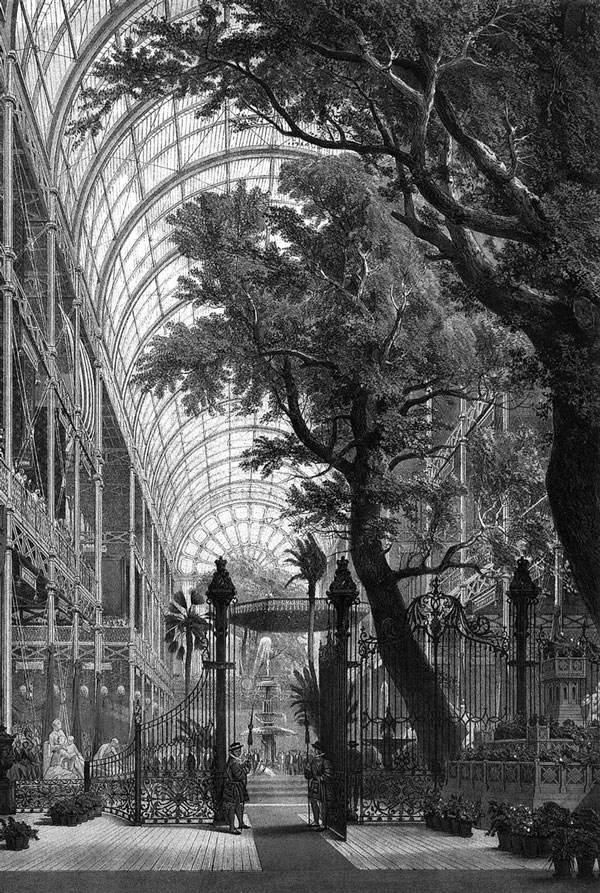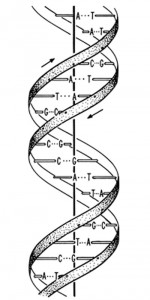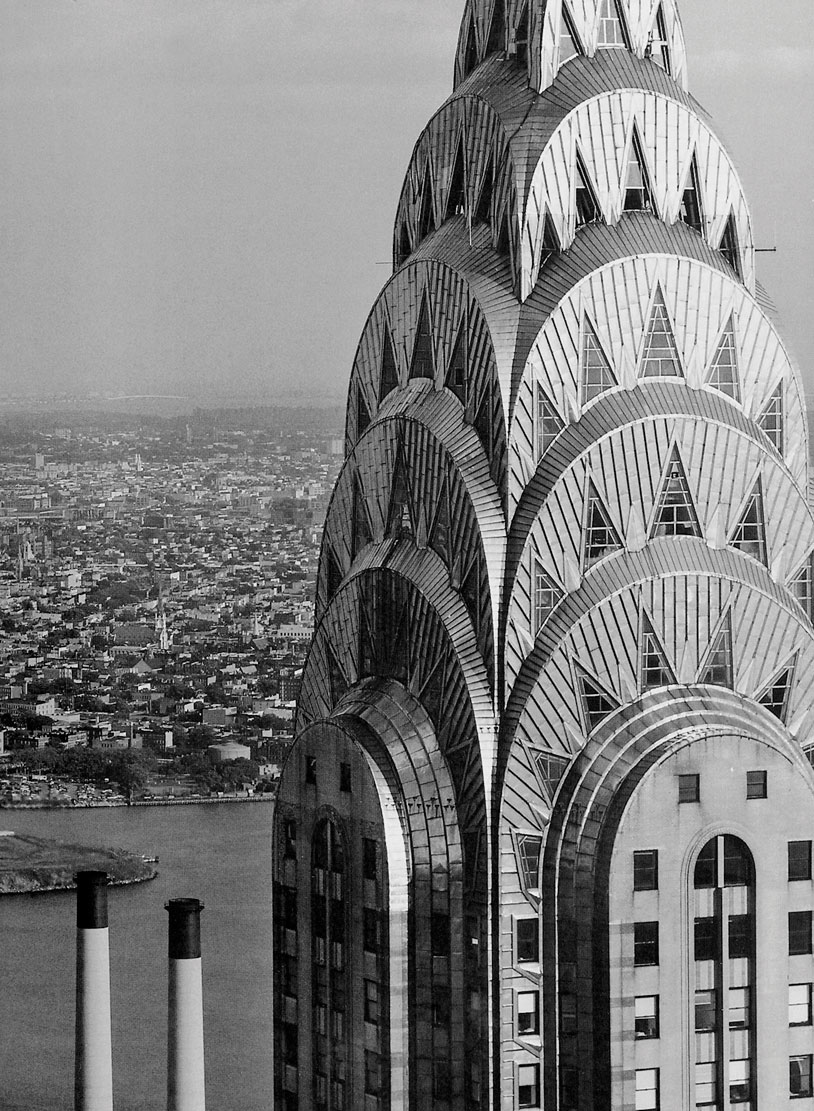At the latest since not only ecological activists and romantic outsiders, but also politicians and film producers are talking about the threatened nature; since even airlines and car producers claim to be contributing to the protection of the climate, has it become clear that the distribution struggle concerning the intermediation of the resource named nature is in full flight. Terms such as “sustainability“, “balance“ and “bio” are on the advance, gas stations are painted green, and garbage is separated in airport malls. “Nature“ as a commodity has massively come in demand. The present high esteem nature as a subject registers offers an occasion to study its history. The notion of “nature“, as it was established in the 18th and 19th century, has altered radically through the 20th century.[1]
Fig.1: Joseph Paxton, Crystal Palace, London, 1851.
The social, political, technological and economic developments, industrially executed wars, as well as the notion that it lies in the hand of mankind to destroy the earth with weapons of mass destruction, have destroyed the idea of nature as something presupposed and inexhaustible. Unto some observers “nature“ can only be thought in inverted commas, or, as American artist Robert Smithson expressed towards the end of the 1960s “simply another 18th and 19th century fiction”.[2] If nature is understood as a fiction – be this as a wish for continuity and coherence, be it as a projection of something completely different that may exist – then the question regarding the relationship between nature and architecture arises anew. If nature is not a presupposed entity, but a product of human projection, i.e. something actually produced in the course of industrialisation, then it is something else than a backdrop against which architecture takes place or a raw material that becomes articulate through architecture. The fact that nature can be represented, that it can be reflected through an image, a text or a semiotic system – or, more precisely that it is unthinkable without representation – also contains the option that it can be modified and manipulated. Seen from such an angle, architecture and nature determine each other.
The history of the relation between architecture and nature since the 19th century can be represented in two different manners. On the one hand as the history of forms in architecture; framing, imitating or transforming the specific forms of nature and its forces. Seen from this perspective, Joseph Paxton’s Crystal Palace at the Great Exhibition of 1851 in London plays a central role. As is generally known, the transept of the building had to be designed in a manner as to spare three old elms in Hyde Park. [Fig.1] These remained unviolated within the glass architecture as an evocation of nature, as an image, so to say, of an entity that in fact had actually been eliminated and destroyed by the architecture. This image of a nature at the same time framed and absorbed by architecture established itself in the 19th and 20th century. From Mies van der Rohe’s buildings, which frame the passing of natural time in its daily and annual cycle and make them perceivable, all the way to the rubber trees, which are to be found in numerous offices, the tale of dominated nature can be followed through the history of architecture and design. Among the protagonists of the imitation of nature, probably Alvar Aalto and Eero Saarinen have been the most influential in the 20th century. They followed organic shapes in the broadest sense. Their manner of applying the materials – be it wood or be it concrete – reflects the forces of nature, which become visible through the materials, i.e. the force of gravity, tectonics, erosion and growth. Their stance is essentially an anti-modernist position, comparable to those of architects and designers such as Antonio Gaudí, Emile Gallé or Hector Guimard during the end of the 19th century, as they sought reference in those forms that had been suppressed by industrialisation. Their formal vocabulary was universally comprehensible after the mid-twentieth century, and not only popular with specialists, but also with politicians and entrepreneurs. One of the reasons for this was the fact that they found forms suitable for disguising the discontinuity and harshness of Modernism, which lent it a quasi “natural” and familiar appearance. Nature as a metaphor allowed inserting something that in principle is unplaceable into a larger context. Another reason was that their projects always communicated, that the forces of nature essentially could be captured and made accessible to humans, that they were not threatening but available. Saarinen’s iconoclastic architecture, such as the TWA Flight Centre in the John F. Kennedy Airport [Fig.2], which reminds of a bird spreading out its wings, his Ingalls Rink in New Haven known as “The Yale Whale” or his Gateway Arch in St. Louis, can immediately be understood by a broad public. Thanks to their evocation of natural models, they create monumental architectures with a capacity for producing identity. Aalto’s architectural projects were not least so successful on an international scale, because they have an anthropomorphic quality independent of their size – a vase, a wooden stool, a students home or the plenar hall of the United Nations – and integrate a human reference in even the most abstract political configurations. Besides Aalto and Saarinen, figures such as Arne Jacobsen, Isamu Noguchi, Charles and Ray Eames adhere to this formal tradition, whose effect extends all the way into our present day in the shape of imitative positions such as those represented by Santiago Calatrava or Luigi Colani.
Fig.2: Eero Saarinen, TWA Terminal, New York, 1956–62.
Whilst this is based upon the assumption that nature and architecture are complementary and that architecture may reflect and emulate nature, the other narrative is based upon the proposition that the concepts of nature and architecture are not separate but interlaced inextricably. This notion, which is relevant for the current debate, is based upon the premise that during the 1930s nature became no longer adequately representable as image or shape in the guise of motives adopted from the realm of plants and animals or as an evocation of the forces of nature. It assumes that the iconographic supply became exhausted at the end of the 1920s or the beginning of the 1930s, and that nature had become invisible, as it were. Simultaneously it assumes that figures like Alto and Saarinen are to be located historically, yet they seem to make less of an impact seen from a present point of view, as their vocabularies were directed backward in time.
From such a perspective, nature is just as designed as design is natural; life is planned in the same way that the plan is something alive. The assumption that nature and architecture cannot be separated calls for the question regarding their relationship to be argued anew. In such a context, architecture is not solely to be understood as the theory and practice of a singular building or the spatial design of our environment, but extends to encompass design, planning and visualization of politics, economy, environment, future and human life in general. The expression describes a series of practices, which directly affect the control and design of human life, such as genetic engineering, climate control, birth control, the organization of associations of nations, the distribution of risks in insurances and pension schemes, as well as the campaigning strategies of politicians and the marketing campaigns of fashion corporations.
Double Helix and Moonrise
A decisive step within this tale regarding the altered view of nature was the novel representation of the structure of genetic material by the American biologist James Watson and the British physicist Francis Crick in Cambridge in 1953. They projected the spatial structure of DNS in the shape of a Double Helix. Their two metre high model became a new emblem for nature. This was a spatial representation that not only allowed to understand the mechanisms of heredity, but also offered the premises for manipulating them – a potential the researchers actually referred to in Nature magazine in 1953: “It has not escaped our observance that the specific pair structure that we assume immediately inspires thoughts regarding a possible copying mechanism for genetic material.”[3] The effect of the image of the Double Helix upon the public was only to be registered with a temporal delay, fifteen years after the discovery and five years after Watson and Crick had received the Nobel prize. In 1968, the publication of James Watson’s bestseller The Double Helix made this geometrical figure a global star. [Fig.3] The message was clear: nature was no longer the mysterious other, which we are at the mercy of, it had become a language we can learn to speak and master. We were not to committed to nature anymore, but rather nature now lay in our hands. By ”decoding” the genetic code, as it was referred to in the language of the cold war in the 1950s, the establishment of a “library of life” as it was called in the language of the Empire around the change of the millennium, had become feasible.
Fig.3: Schematic Illustration of the Double Helix.
The triumph of the Double Helix coincided with another eminent image of nature, i.e. the photographs by NASA of the planet earth. [Fig.4] The proliferation of the pictures taken from Apollo 8, which showed the blue planet in a black universe or a rising earth above a moon horizon influenced the concept of nature for a generation. Nature was visually unfathomably magnified and unfathomably minimised as a system of molecular components on the one hand and as a vulnerable, self-contained system exposed to a vast nothingness on the other side. The term nature was hence replaced by the notion of holistic systems and power relations, of which humans were a part, yet whose continuity and destiny they could partially determine themselves. This shift of scale led to the product becoming less important than the process, the form less important than the function.
Fig.4: Cover Life Magazine, June 10, 1969.
Typical events for the shift in design of that period were projects like the Whole Earth Catalogue, which appeared between 1969 and the early 1970s; an encyclopaedic collection of objects that should allow to design human environments more favourably, to save limited resources and to develop alternatives to the established forms of industrial life. [Fig.5] The Whole Earth Catalogue and the environmental movement forming around that particular time – prominently NGO Greenpeace, founded in 1971 – aimed at protecting the fragile system of the earth and established a new lifestyle simultaneously. Paradoxically, corporations pursuing completely different motives succeeded in operating under the sail of this new paradigm. The drastic price increase, which the consumers of the western industrial countries were subjected to, due to measures applied by the international energy corporations and OPEC, the beginning of what is called globalization since the 1990s, was understood by large portions of the public as a “natural” problem, i.e. as an effect of the fact that crude oil resources are finite, and not as a result of ruthless exploitation or the cynical machinations of monopolies.[4] The image of a tiny blue planet was already so intensely established in people’s minds that consumers accepted the arbitrary price hike and the consequent economic crisis as a natural phenomenon and did not combat it as a political and economic decision. Genuine global players such as IKEA or Benetton began not only to deliver low-price high-quality furniture and clothes to the international middle classes in the 1970s, but also to establish an international lifestyle, which suggested local identity and incorporated “naturalness”.
Fig.5: Cover Whole Earth Catalogue, Spring 1970.
The Large Whole
As the process became more important than the product, the system more important than the form, the event more important than the object, so did the traditional boundaries of trades and professions begin to become blurred. The key figure was Richard Buckminster Fuller, in whose multi-faceted practice the definitions of architecture, art design, theory and fiction became instable. Already in the 1920s had Fuller started to develop new technical visions. His success is inseparably interweaved with the U.S. military industry, for which concepts of mobile architectures were developed, which should function like systems. The emerging concepts for self-sustaining systems – the tensegrity system, for example – were used for military structures such as protective covers for radar antennae, and soon found alternative utilisations in exhibition architecture and mobile forms of housing, which interested the readers of the Whole Earth Catalogue, for instance. Buckminster Fuller’s utterance “think global, act local” became the slogan of a movement, which at all times remained conscious of its responsibility to the entire system of the earth and was later exploited by the global economy. Fuller’s most prominent work, the American pavilion for the 1967 Expo in Montréal, is emblematic for a design that sees itself as an autonomous natural sphere. Until this day, the object named Biosphère keeps attracting an audience. [Fig.6]
Fig.6: Richard Buckminster Fuller, Biosphere, Montreal, 1967.
At first sight, with other words, Fuller’s architecture does not adopt any natural shapes. But his concepts all refer to systematic entities, power relations, as well as the relation between humans and their environment. This is comparable to the output of German architect Frei Otto, who became famous through his surface structures in the 1950s. In later publications, Frei Otto explicitly refers to inspiration through natural forms, but his projects, just as his main work the Olympic Stadium in Munich 1972, are like Buckminster Fuller’s self-contained systems based upon modular units, in which even the smallest detail corresponds with the whole.
While Fuller and Frei Otto most of all influenced engineers and stood outside the canon of art and architecture history, Friedrich Kiesler was an integrative figure since the 1950s, leaving his marks in the fields of exhibition design, visual art and architecture. His Endless House is conceived entirely from the interior spaces and creates spatial boundaries floating into one another; enveloping the inhabitants without submitting them to an arbitrary systematic or aesthetic convention. [Fig.7] For the artists of the late 1950s, Robert Rauschenberg, Allan Kaprow or Claes Oldenburg, for instance, Kiesler was so inspiring, because he articulated Environments, which surrounded people with specific material and atmospheric situations, as well as allowed them to modify these surroundings.
Fig.7: Friedrich Kiesler, Endless House, 1959.
Fuller’s and Kiesler’s activities commenced in the 1930s, even though their effect did not unfold until between the 1950s and the 1970s, and their influence once again became perceptible during the expiring 1990s. If the emerging consciousness regarding the vulnerability of nature sensitised the public for images such as the Double Helix and planet Earth, the question must be discussed, why nature eluded visibility in the 1930s. Why was nature suddenly no longer perceived as form, but as a system? Why are there so many attempts during the phase known as “rappel à l’ordre“, to fix an environment perceived as chaotic in clearly defined shapes within the visual culture of the 1930s? The obsession of artists, architects and designers for monumental forms is symptomatic for the decay of the old order. This becomes especially clear in the penchant of the period for crystalline structures. From the surfaces of the skyscraper facades in New York and the glittering inclusions in the entry hall of Chrysler Building in New York, all the way to the surface of shellac sheats and even the musical structure of jazz, a preference for crystalline structures is to be observed. [Fig.8] It is an emphasis of discontinuity and inner contradiction, an alternative image opposing the soft, organic shapes that dominated the visual culture for decades before – and at the same time a reference to entirely different molecular power processes, which also are to be found in nature. If the hypothesis is correct that the economic shift of the late 1960s and early 1970s presents the occasion for establishing a new vision of what nature is, the destruction of the preceding image of nature could have occurred due to the economic crisis of 1929. In contrast to the triumph of capitalism and the beginning of globalization in the early 1970s, whose most eminent image paradoxically is that of the “Oil Crisis”, there exists no image for the moment of complete collapse of the economic system, namely the Great Crash of 1929. At that time capitalism experienced a defeat it seeks to avoid by all means ever since. In its loss of control over the market forces, its nature was exposed for a short moment – a scandalous, immensely aggressive nature, infinitely more threatening than all thunderstorms, volcanic eruptions and ocean gales together. Never again, so much was clear unto all, should the market forces remain unbridled. In the future they had to be controlled and designed. It is this nature, for which no image may exist in Modernism, which must remain repressed. The history of the relation between architecture and nature is a function of economic history.



















